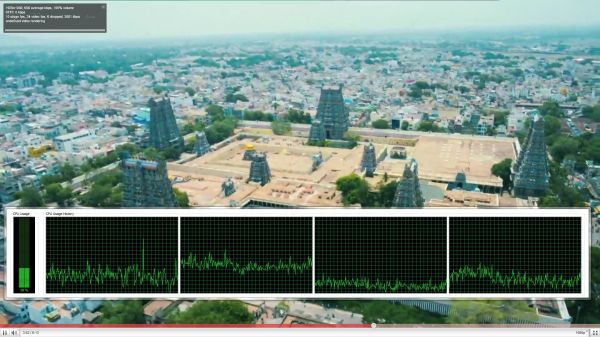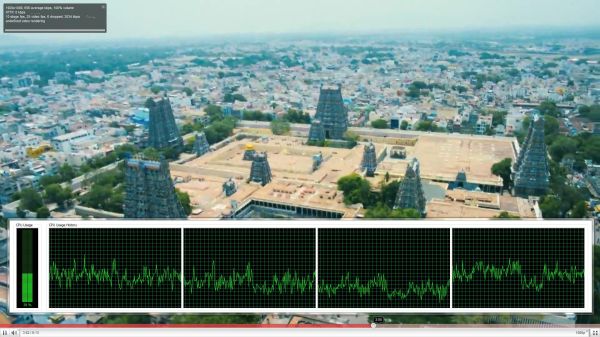Dell Zino HD 410 HTPC Review
by Ganesh T S on February 19, 2011 7:08 AM EST- Posted in
- HTPC
- Dell
- AMD
- Media Streamer
- ATI
The Zino 410 is covered quite nicely with respect to networking hardware. With support for both Gigabit Ethernet and 802.11n, it really doesn't matter if you keep the unit beyond cable reach from the router. All our network streaming tests were carried out with a 300 Mbps 802.11n network (currently provided in my lab location by a RT-N16 802.11n gigabit router from Asus). We were easily able to stream HD clips of more than 50 Mbps. HD YouTube videos and HD Netflix streaming had no issues.
While on the topic of network streaming, let us take a brief look at how the system performs while accessing online video services. We used Flash 10.1 in Firefox 3.6 with ATI Catalyst 11.1 for testing.
The first set of screenshots below show the CPU usage while playing back a 1080p YouTube video with and without hardware acceleration enabled. This is the same clip as the one used in the Core 100 and Vision 3D reviews. As can be seen, the GPU indeed supports Flash acceleration. However, the difference between the hardware accelerated and non-hardware accelerated CPU usage is around 11% only (39% for no hardware acceleration and 28% for hardware acceleration). We expect similar results for videos on Hulu.
1080p YouTube HD Streaming without Hardware Acceleration

1080p YouTube HD Streaming with Hardware Acceleration
Netflix streaming, on the other hand, uses Microsoft's Silverlight technology. Unlike Flash, hardware acceleration for the video decode process is not controlled by the user. It is upto the server side code to attempt GPU acceleration. Thankfully, Netflix does try to take advantage of the GPU's capabilities. This is evident from the A/V stats recorded while streaming a Netflix HD video at the maximum possible bitrate of 3.8 Mbps. While the video is definitely not 1080p, we observe that the CPU utilization of around 40% is higher than the CPU usage for a 1080p YouTube video.

Netflix HD Streaming with Hardware Acceleration
We suspect that the handling of the DRM in the case of Netflix streaming is done by the CPU, resulting in the higher usage.
Users of media streamers streaming online videos often have to put up with messages of the sort 'This content is not available on TV connected devices' or need to queue up the videos on a PC before accessing them through their media streamer box. HTPC users don't need to worry about any such limitations. For online media consumption, the Zino 410 is as good as the Core 100, but not as efficient as the Vision 3D.











69 Comments
View All Comments
myangeldust - Saturday, September 10, 2011 - link
An internal tuner would up the heat generated and require a larger case. But Dell should have offered the option for a tuner.A great HTPC would have a SSD and a NTSC/ATSC/radio dual tuner with a motorized slot drive for DVD/BD. The case could act as an antenna for TV/radio reception and made laptop thin to fit on the back of your HDTV. Though it would be a separate model for a more expensive niche market. Still cheaper than most Macs though.
tipoo - Saturday, February 19, 2011 - link
I've been waiting for an AT review of the Zino HD, thanks! I wonder if AMD's Brazos chips will make their way into this? Looks like it can handle much higher watt parts (ie the x4), but as a base config that would be nice.Trefugl - Saturday, February 19, 2011 - link
I was going to make the same comment about Brazos.I've had my eye on the Dell Zino 410 for a long time, but now that Brazos is around I am thinking of either building something of my own or waiting until someone like Dell produces a system.
Ganesh, do you know (or suspect) if Dell has a Brazos update to the Zino planned? I think a small system like that would be nearly perfect for an HTPC.
Edgar_Wibeau - Saturday, February 19, 2011 - link
My guess is, AMDs 2nd APU, Llano, will find its way into this Box. It will also solve the graphics-being-too-slow-issue if it is an issue for some. Llano is supposed to hit the market in summer. Llano will be based on 32nm tech and feature a GPU that is at least twice as powerful as the one in Zacate. The CPU part will also be significantly faster than Zacate as it will be the successor to the current Athlons/Turions/Phenoms in notebooks. On the down-side, it'll also be more expensive than Zacate of course.ganeshts - Sunday, February 20, 2011 - link
My educated guess is that the next generation Zino HD's base configs will be based on Zacate.Our initial look at Brazos indicates that it is as weak as the Mobility 5450. I wouldn't expect great things in the $300 - $500 configs.
As you also mention, I am looking forward to the Llano to make an appearance in the high end configs. I expect none of the configs would need a discrete GPU making it easier for Dell ( but, first, Llano needs to come to the market ! )
Spacecomber - Saturday, February 19, 2011 - link
Would it have made any sense (and been practical) to get some numbers on the integrated 4250 graphics solution? I found myself wondering how much the advantage was with the upgrade to the discrete 5450.At some point, it would be helpful to get a sound-level meter, given how important (and subjective) judgements of what is quiet can be when talking about home theatre and audio PCs.
Nevertheless, enjoyed the read; thanks for the review.
DanNeely - Saturday, February 19, 2011 - link
80SP @ 675 vs 40SP @ 500 is a 2.7x factor; and while a crude comparison is sufficient to show the 4250 would be crushed on light gaming benchmarks.The closest I could find in the first few pages of reviews here was a laptop with the 4225 (40SP @ 380) which is crushed by about 3x in FPS vs the 5450; I didn't see anything comparing their abilities in video decoding.
http://www.anandtech.com/show/3862/toshiba-t235d-a...
DNW - Saturday, February 19, 2011 - link
I am looking for a computer for my home theater. I never play games. I do watch a lot of television and movies. Blu ray performance would be important to me. I also have a large collection of 40 years of home movies originally shot on everything from beta to vhs to digital, all of which I have digitized and would like to watch.I need a computer and not a Google TV or WD Live box because these and similar solutions will not play all my videos, all of which play just great on a computer. My monitor is an Olevia 65" LCD TV. Is the size/type of TV a factor, or not factor?
Will the Zino HD410 suffice for my purposes (if so, what configuration), or do I need to get something more powerful? Naturally, I would like to keep costs to a minimum, but not to the extent that my objectives are not met.
ganeshts - Sunday, February 20, 2011 - link
If it is just Blu-Ray you are interested in, and not any recorded TV content / content from friends, then the Zino 410 as reviewed is good enough. I can't vouch for the capabilities of the other configs.The TV to which it is connected is not an issue 99% of the time. (Sometimes, there could be problems with HDMI handshake, but a quick Google search of 5450 + Olevia model number would reveal that)
capeconsultant - Saturday, February 19, 2011 - link
The 3.5 inch drive is hotter, uses more power, and takes up more space that could be used for thermal and/or design purposes. Desktop or NAS ONLY for 3.5 please.